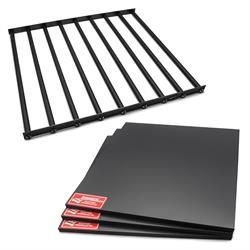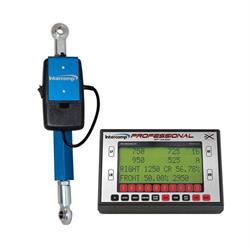Race Car Weight Distribution & How to Corner Balance
What is Car Weight Distribution?
We’re all familiar with the idea of car weight distribution. Even in street driving, we can feel the dynamic differences as weight is shifted around. A ’69 Camaro with an iron big block will have drastically different behaviors than a Porsche 911 with the engine hung out over the rear. A dirt Late Model will have significantly different characteristics than a Hobby Stock. That’s static weight distribution. When setting up a race car, it’s important to be mindful of static weight distribution, but it’s also important to add the critical tuning step of corner balancing.
Corner balancing is the process of carefully shifting the weight on each wheel by adjusting spring heights. When preparing a car for competition, corner balancing is a critical step to achieve a neutral, balanced car that reacts predictably when cornering in either direction. The desired outcome of corner balancing is to achieve a balance where the left front and right rear corners hold up half the car’s weight, while the right front and left rear corners carry the other half. An imbalanced car will react differently and unpredictably when turning in different directions. Not an issue when corner-carving the roundabouts by the local strip mall, but a critical and necessary step when setting up a race car that’s going to be driven on the edge where predictable and repeatable performance is required.
It’s important to make note of a critical distinction here. Corner balancing and static weight distribution are different things. Corner balancing can only adjust weight on the diagonal corners. Front to rear (think of our Camaro and Porsche examples) and left to right balances can only be changed by moving weight around in the car by adding ballast or making adjustments to the position of large components like the engine, driver position, and fuel cell.
Also note that in some circumstances, a “balanced” car is not the goal. Circle track setups, for example, often target different percentages. These cars are only turning left and typically use scales to baseline their setup, then make changes at the track to fine tune the car to that night's racing conditions. More on this later.
How to Calculate Weight Distribution of a Race Car
Corner balance scales will record weights and percentages and are a critical tool for race car setup. They do most of the mathematical heavy lifting and display critical weights and percentages. But before we get to the process of scaling, it’s important to understand how cross weight is calculated. Cross weight is determined by the left rear and right front weight percentage and can be expressed by the following formula:
If the cross weight is more or less than 50%, then the car is said to have “wedge.” In a scenario where you’re tuning a car to have neutral handling when turning both right and left, wedge is undesirable. Therefore, you’re targeting a cross weight percentage as close as possible to 50%. It’s worth noting that it’s hard to achieve a perfect number in the real world. Try to get as close as possible.
How to Corner Weigh a Race Car
Let’s discuss the process of corner weighing a car. In this scenario, we’re going to assume that a neutral car with balanced cross weight percentages is the goal. Before we get started, there are some preliminary steps that will ensure the best results from the corner balancing process.
Top off all fluids. Fluids can have a huge impact on weight percentage, especially fuel. Try to set your fuel level as close as possible to the way the car will be raced. If significant fuel will be consumed during the race, then there will be some compromises made here.
It’s best to have the car aligned before scaling. Changes to things like caster can jack weight and will affect corner weights. If possible, it’s a good idea to touch up alignment settings after corner balancing as well.
Set the car to the desired ride height. It’s best to measure from the floor to the frame to eliminate any variation in body panels like rocker panels or fenders.
Don’t forget that the weight of the driver will affect the car’s balance. Set the seat where it will be raced and either weigh with the driver (or a person of similar size) behind the wheel or simulate the driver with sandbags or other weight.
Be sure the tires are aired to the desired pressure.
It’s very important to remember to disconnect the sway bars. This can be done by unhooking only one end link per bar, just take care that the loose link or bar end doesn’t get jammed up in the suspension and cause an unforeseen bind.
Before putting the car on the scales, please remember that safety is very important here. The car will be up on the scale pads and you will be working underneath it. It’s very important to take every precaution to keep the car from rolling off the scale pads. Use wheel chocks, scale with the car in gear, or have the brakes held on.
Now we’re ready to set up the scales. It’s critical that each of the four scale pads are level with one another. Set up on the most level part of your shop floor. For fine tuning, scale pad levelers are extremely handy. Otherwise, pieces of sheet metal or linoleum floor tiles work well as shims to level the pads.
When the scales are set up and leveled, turn them on and make sure each is zeroed out before setting the car on them. Once you set the car on the scales, you need to settle the suspension. You’ve likely experienced a car with an independent suspension “settling” or “rolling out” when you jack up the frame with a floor jack, then drop it back down on the shop floor. An unsettled suspension will create a huge amount of inconsistency once you start the corner balancing process. Some scale levelers have a roll-off area that allows you to roll the car back and forth to settle it. Slip plates allow the tires to move out as the suspension settles to prevent binding. Otherwise, simply driving on the pads with ramps is a great place to start that will prevent the suspension from unloading and then binding when set on the scales. It’s also important to remember to settle the suspension after making adjustments. A few hard shoves on each corner usually does the trick.
With the car on the scales, it’s time to start balancing. This process assumes that the car has coilovers or weight jacks to allow for adjustment to spring heights. Generally, raising or lowering the spring on a corner will add or remove weight on that corner, with minimal changes to the others.
Most modern digital scales will calculate cross weight and display that along with the corner weights.
To correct a cross above 50%, take weight out of the Right Front, Left Rear or add turns to the Left Front, Right Rear.
For a cross weight below 50%, you’ll want to add weight to the Right Front, Left Rear or decrease weight on the Left Front, Right Rear.
In the case of the Nova in the photos, the car has a 48.36% cross. In the real world, this is not a bad number and this is a setup that we have dialed in on this car through many sessions on the track. If we wanted to move this number closer to 50%, we would add weight to the RF/LR or decrease weight on the LF/RR.
It’s important to remember that when adjusting weights you’re also affecting ride height. Therefore, it’s best to make small adjustments to each corner than large adjustments to only one. This is a skill that takes some practice and some patience. This is not a process to be rushed.
We’ve been discussing how to corner weigh a car to achieve neutral handling when turning in both directions. This setup applies to road racing, autocross, and the like. But what about a car that will only be turning one direction, like a circle track race car? Computer scales are a valuable tuning tool for these cars as well, but the desired outcome will be different.
First, the preparation process described above also applies here. Top off fluids, weight in the seat, tires aired up, etc. It’s common for these cars to run multiple wheel offsets, so be sure to balance with the set that will be run at the track.
The main difference with a circle track setup is that there’s more than one right answer. Instead of 50% cross weight as the desired outcome, the ideal percentage for circle track racing will vary from car to car, track to track, and driver to driver. Circle track drivers and crew chiefs typically use scales to dial in a baseline, often using recommendations from the chassis builder, then fine tune based on track conditions and driver preferences. Spring smashers and load sticks are also used on these cars as supplemental setup tools.
Generally, circle track setups place great emphasis on the left and rear percentages as well as bite. Put simply, bite is the weight of the left rear in relation to the right rear, and many scales will display this number. Bite matters to the setup because adding weight to the left rear tends to tighten the car, while adding weight to the right rear tends to loosen the car. Under throttle, the rear tire with the most weight will cause the car to rotate away from that corner. Adjustments to rear weights and bite can be made in response to changing track conditions throughout the night. It's also important to remember that scales measure static weight and do not account for dynamic forces like downforce and weight transfer.
What Type of Scales Do I Need to Corner Balance My Race Car?
Speedway Motors offers a wide variety of corner balance scales and accessories to accommodate just about any race type and any budget. Speedway Motors 1 Weigh Electronic Racing Scales are a great budget-friendly scale set to start out with. These scales display all four wheel weights and percentages as well as cross weight and bite.
As your skills and setup requirements grow, it may be time to upgrade to a more advanced set of scales. Our Nova setup above was done on a Longacre Wireless Tablet set and it has some very useful features. First, the wireless setup for both the tablet and the scale pads is a huge time and frustration saver. Think of the difference between using a cordless drill in the shop and a hand drill that plugs into the wall, then multiply that annoyance by four. Beyond the convenience of wireless, the tablet offers a huge increase in display flexibility as well as memory of multiple setups.
Regardless of the scale set you choose, we’re sure that you will immediately wonder how you ever lived without one. Knowing the numbers behind your race car weight distribution will help you make informed decisions about your setup, and as your tuning skills improve you’ll see more and more of the picture every time you put your car on the scales.





